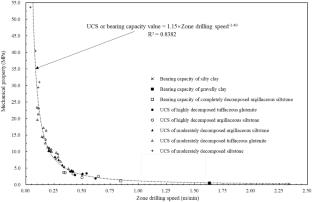It is challenging yet essential to identify the different processes and operations for the wide utilization of factual data during the current normal drilling. In this paper, the complete digital factual data of the hydraulic rotary drill project are recorded in real-time series along a 38-m-deep drillhole. A total of five processes with the associated individual operations are identified by the digitalization results as the inserting drill bit and rods process, the rotary stirring process, the hydraulic rotary coring process, the core cutting process, and the retrieving drill bit and rods process. The operations of net drilling can be selected by the statistical results from the hydraulic rotary coring process. According to the factual data, 461 linear zones and 10 geomaterial-type zones with the corresponding constant drilling speed are presented in the curve of bit advancement depth versus the net drilling time. The analysis results show that as the in situ mechanical property (or coring-resistant strength) of the drilled geomaterials increases, the corresponding constant drilling speed decreases. The spatial distributions of linear zones with similar constant drilling speeds can represent the stratum distributions of homogeneous geomaterial. The digitalization results provide the valuable reference for quantitative descriptions of the full hydraulic rotary drilling process and the in situ mechanical profile with the factual drilling data.


